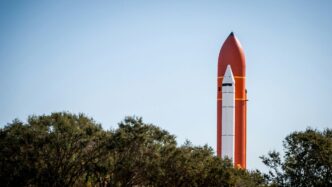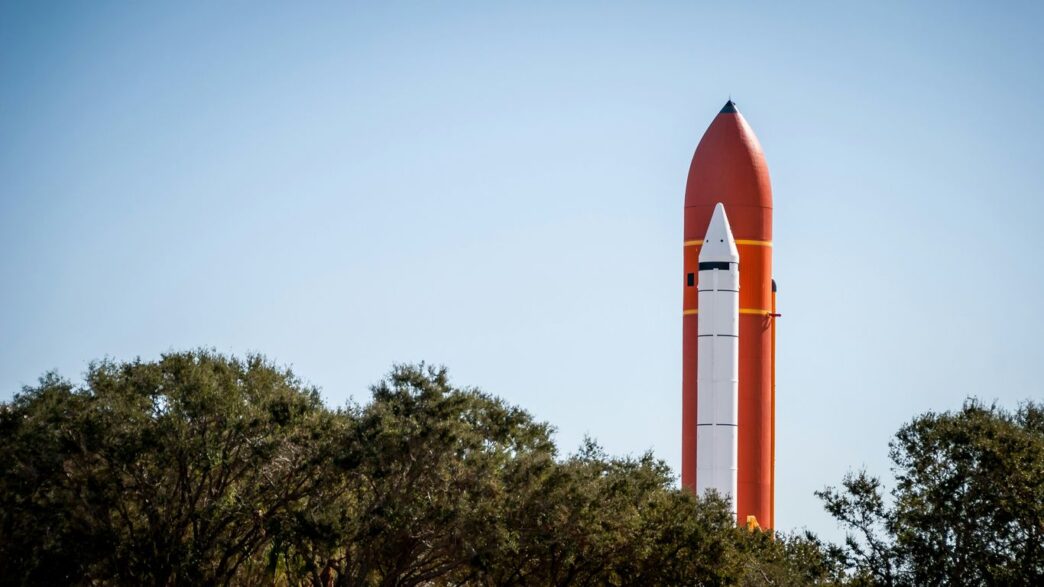Hey everyone, welcome back to the blog! Today we’re diving into the latest happenings in US space news. NASA’s been busy, and there’s a lot to cover, from missions keeping an eye on our planet to big steps forward in heading back to the Moon and exploring further out. Let’s get into it.
Key Takeaways
- New Sentinel-6B satellite is now monitoring Earth’s oceans, helping with weather forecasts and shipping.
- The ESCAPADE mission is on its way to Mars to study how the Sun affects the planet’s atmosphere.
- NASA is getting ready to send a VIPER rover to the Moon’s South Pole.
- The Artemis program is growing with more countries joining the Artemis Accords, and the Artemis II crewed mission is getting closer.
- Scott Tingle has been named the new Chief Astronaut, and a new crew is heading to the International Space Station.
Latest NASA Mission Updates
NASA’s got a lot going on, and keeping track of all the missions can feel like a full-time job. But don’t worry, we’ve got you covered with the latest on some key projects.
Sentinel-6B: Monitoring Earth’s Oceans
This joint US-European mission is all about keeping a close eye on our planet’s oceans. The Sentinel-6B satellite, about the size of a pickup truck, is designed to provide really important data about sea levels and ocean conditions. This information helps us get better hurricane forecasts, protect coastal areas, and even helps with things like shipping. It’s basically a super-advanced weather station for the seas.
ESCAPADE Mission to Mars
Heading to the Red Planet, the ESCAPADE mission is actually two spacecraft. Their main job is to study how Mars’s magnetic field interacts with the solar wind. Think of it like studying how a planet’s shield holds up against space weather. This research is not just about Mars itself, but also helps NASA plan for future human trips there. It’s a pretty big deal for understanding planetary environments.
VIPER Rover Delivery to Lunar South Pole
NASA is getting ready to send its VIPER rover to the Moon’s South Pole. This is part of the bigger Artemis program. The rover’s job is to look for water ice and other resources in the permanently shadowed craters near the pole. Finding these resources could be a game-changer for future lunar bases, making it easier to support astronauts living and working on the Moon. It’s a big step towards a more sustainable presence beyond Earth.
Artemis Program Progress
The Artemis program is really picking up steam, aiming to get humans back to the Moon and eventually to Mars. It’s not just about planting flags; it’s about building a sustainable presence and learning how to live and work off-world. This ambitious endeavor involves a lot of moving parts and international cooperation.
Artemis Accords Expansion
NASA and its international partners have been busy expanding the Artemis Accords. These are basically a set of principles to guide space exploration responsibly. Think of them as the ground rules for going to the Moon, Mars, and beyond. More countries are signing on, which means more collaboration and a shared vision for exploring space.
Here’s a look at what the Accords cover:
- Peaceful Exploration: Ensuring all activities are for peaceful purposes.
- Transparency: Sharing scientific information openly.
- Interoperability: Making sure systems can work together.
- Emergency Support: Providing aid to astronauts in distress.
- Registration of Space Objects: Keeping track of what’s launched.
- Space Resource Utilization: Addressing how we’ll use resources found in space.
- Deconfliction of Activities: Preventing harmful interference between different operations.
- Orbital Debris and Spacecraft Disposal: Managing space junk responsibly.
Artemis II Crewed Moon Mission
This is the big one everyone’s waiting for – the Artemis II mission. It’s going to send astronauts on a journey around the Moon, the first crewed mission to leave Earth’s orbit in decades. While it won’t land on the Moon, it’s a critical step to test out all the systems and procedures needed for future lunar landings. The crew will get a close-up look at the lunar surface and experience the challenges of deep space travel firsthand. This mission is all about proving the hardware and the human element before the actual landing missions begin.
Astronaut Corps and International Collaboration
It’s been a busy time for NASA’s astronaut corps and its international partners. The agency recently announced Scott Tingle as the new Chief Astronaut, taking the helm at Johnson Space Center in Houston. Tingle, a veteran with over 4,500 hours in space, steps into this role with a wealth of experience. This leadership change comes as NASA continues to push the boundaries of human spaceflight.
Speaking of pushing boundaries, a new crew recently launched to the International Space Station. Astronaut Chris Williams, along with cosmonauts Sergey Kud-Sverchkov and Sergei Mikaev, blasted off on the Soyuz MS-28 spacecraft. They’re now part of Expedition 73, contributing to ongoing scientific research aboard the orbiting laboratory. This kind of international teamwork is what makes long-duration space missions possible.
Beyond the ISS, the Artemis program is also seeing significant international engagement. NASA and representatives from global space agencies recently met to discuss the Artemis Accords. These accords are basically a set of guidelines for how we should explore the Moon, Mars, and other places in space responsibly. It’s all about making sure everyone plays nice and works together as we venture further out.
Here’s a quick look at some recent astronaut activities:
- New Astronaut Class: NASA selected its 2025 class of astronaut candidates. These folks will go through some serious training before they can join the active corps. You can find more details about NASA’s astronaut candidates and their journey.
- ISS Continuous Presence: This year marks 25 years of humans living and working on the International Space Station without a break. Since 2000, over 290 people from 26 countries have spent time there, doing all sorts of science.
- Artemis II Mission: Preparations are underway for the Artemis II mission, which will send astronauts on a journey around the Moon. This is a big step towards returning humans to the lunar surface.
Advancements in Space Technology and Research
It’s pretty wild how much is happening in space tech these days. NASA’s been busy pushing the boundaries, and some of the projects are just fascinating. Take the X-59 aircraft, for example. It’s designed to fly faster than sound, but without that usual ear-splitting boom. The goal is to make supersonic flight quieter, which could change air travel as we know it. They’ve already had its first flight, and it seems to be on track for more testing. It’s all part of the Quesst mission, trying to figure out how to make that happen.
Then there are the missions focused on understanding our solar system better. NASA and NOAA teamed up to launch three new spacecraft. These aren’t just looking at one thing; they’re mapping how the Sun’s activity affects space all around us. This kind of data is super important for everything from protecting satellites to planning future trips to other planets. It’s like getting a real-time weather report for the entire solar system.
Speaking of keeping things running smoothly, NASA is also looking at ways to keep its existing satellites in good shape. They’ve awarded a contract to a company called Katalyst Space Technologies to help boost the orbit of the Swift Observatory. This means the telescope can keep doing its job observing the universe for longer. It’s a smart move to get more out of our investments in space.
And it’s not just about building new rockets or planes. NASA is also investing in citizen science, funding new projects for 2025. This lets regular folks get involved in real research, which is pretty cool. It shows they’re serious about bringing more people into the space exploration effort.
Exploring the Cosmos and Our Solar System
It’s pretty wild to think about how much we’re learning about space these days. NASA’s TESS satellite, for example, has been doing some amazing work. Recently, it helped astronomers get a much clearer picture of the Pleiades star cluster. They used TESS data, along with info from other telescopes, to really dig into what’s going on out there. It’s like TESS is giving us a super-powered magnifying glass for the universe.
Then there’s the NISAR satellite, which is just starting to send back its first images. This joint mission between NASA and the Indian Space Research Organisation (ISRO) is designed to give us a detailed look at Earth’s land surfaces, ice sheets, and oceans. The goal is to track changes happening on our planet, which is super important for understanding things like climate change and natural disasters. These new images are expected to provide unprecedented detail about our changing world.
We’re also keeping a close eye on the Sun. Understanding space weather, those bursts of energy and particles from the Sun, is key. Missions dedicated to monitoring this help us predict things like solar flares and coronal mass ejections, which can mess with our satellites and power grids here on Earth. It’s a constant effort to stay ahead of whatever the Sun throws our way.
Here’s a quick look at some of the ongoing efforts:
- TESS (Transiting Exoplanet Survey Satellite): Continues to scan the sky, finding new planets outside our solar system and studying star clusters like the Pleiades.
- NISAR (NASA-ISRO Synthetic Aperture Radar): Now operational, it’s beginning to map Earth’s surface with radar, showing us changes in ecosystems, ice, and land.
- Solar Monitoring Missions: Various spacecraft are always watching the Sun, gathering data on its activity to help us prepare for space weather events.
US Space News Highlights
NASA continues to be a major player in space innovation, pushing boundaries and bringing people together for exploration. It’s pretty amazing what they’re up to.
NASA’s Role in Space Innovation
NASA isn’t just about big rockets and moon missions, though those are pretty cool. They’re also working on making things quieter, like with the X-59 aircraft that’s designed for quiet supersonic flight. Imagine planes breaking the sound barrier without that usual boom! They’re also looking out for us with space weather monitoring missions, trying to predict solar flares and other events that could mess with our technology here on Earth. And get this, they’re even working on boosting the orbit of existing satellites, like the Swift Observatory, to keep them working longer. It’s all about making space tech better and more useful.
Citizen Science Initiatives
It’s not all just scientists in labs, either. NASA is really getting the public involved through citizen science. Projects like the Student Airborne Research Program (SARP) give students hands-on experience, letting them present their research after a summer of work. It’s a great way for young minds to get a taste of real scientific investigation. Plus, there are other ways for anyone to contribute, helping analyze data or spot interesting things in space. This kind of involvement makes space exploration feel more like a shared adventure.
Continuous Human Presence on ISS
We’ve hit a pretty big milestone: 25 years of people living and working on the International Space Station (ISS). Since November 2, 2000, astronauts from all over the world have been up there, doing science and keeping the station running. It’s a testament to international cooperation and our drive to understand what happens when humans live in space for extended periods. This ongoing presence is vital for preparing for longer missions, like those planned for the Moon and Mars. Speaking of the Moon, the Artemis II crewed mission is getting closer, with a target launch no later than April 2026, marking another step in our return to lunar exploration.
Looking Ahead
So, that’s a quick look at what’s been happening with NASA and space exploration lately. From watching our oceans with new satellites to getting ready for Mars missions and even boosting old ones, it’s clear things are busy. Plus, with new astronauts joining the team and international partners working together on things like the Artemis Accords, the future of space travel feels pretty active. It’s exciting to see all these projects moving forward, and we’ll definitely be keeping an eye on what comes next.
Frequently Asked Questions
What new missions are NASA working on to study our planet?
NASA has launched new satellites like Sentinel-6B to keep a close eye on Earth’s oceans. This helps us understand sea levels better and predict hurricanes. They also have the ESCAPADE mission heading to Mars to study its atmosphere and how it interacts with the sun. Plus, the VIPER rover is getting ready to explore the Moon’s south pole!
What’s happening with the Artemis Program?
The Artemis Program is NASA’s big plan to go back to the Moon and eventually to Mars. More countries are joining the Artemis Accords, which are like rules for exploring space peacefully. The Artemis II mission is getting ready to send astronauts on a trip around the Moon, a huge step towards future exploration.
Who is in charge of NASA’s astronauts now?
Scott Tingle, a seasoned astronaut with lots of experience, has been named the new Chief Astronaut. He’ll be leading the team of astronauts at NASA’s Johnson Space Center. Also, a new crew recently launched to the International Space Station to continue important science experiments.
Are there any cool new flying technologies being tested?
Yes! NASA’s X-59 aircraft is testing out ways to fly faster than sound without making a loud boom, which could change air travel in the future. They are also sending up new missions to watch for space weather, which is like the Sun’s storms that can affect us here on Earth.
What have NASA’s telescopes discovered lately?
NASA’s TESS satellite has been busy finding new planets outside our solar system. The NISAR satellite, a joint project with India, has sent back its first amazing pictures of Earth, showing us our planet in new detail. These tools help us learn more about space and our place in it.
How does NASA involve regular people in space exploration?
NASA has many ways for everyone to get involved! They have citizen science projects where people can help analyze data or spot interesting things in space. NASA also shares a lot of information about its missions and discoveries, showing how innovation and exploration benefit everyone.












